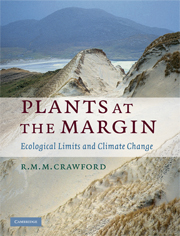Book contents
4 - Reproduction at the periphery
Published online by Cambridge University Press: 06 July 2010
Summary
ENVIRONMENTAL LIMITS TO REPRODUCTION
Limits to plant distribution can arise either from a failure to grow or an inability to reproduce. In many cases a failure to reproduce may be a more common response to environmental limitations than a failure to grow, probably because reproductive success requires more than just the development of viable seed. Reproduction is accomplished only when there is successful establishment of a new generation of reproductive individuals. The continued existence of viable populations in marginal areas is therefore dependent on accomplishment of flowering, fertilization, viable seed production, germination, and the establishment of new individuals in regions where the environment is uncertain and variable. These basic requirements for completion of the reproductive cycle illustrate the appropriateness of measuring genetic fitness in the Darwinian sense as the ability of an individual to contribute genetically to the next generation.
Fortunately, at least for some perennial plants, the arrival of the next generation is not as urgent as it is in animals with their genetically fixed and discrete lifespans. For plants in marginal situations failure to reproduce sexually due to climatic deterioration does not necessarily result in abandonment of the habitat.
‘Adapt or migrate’ is sometimes presented as the only possible choice open to organisms that live in fluctuating environments where adversity may make sexual reproduction not possible for long periods. Reasonably regular sexual reproduction may be necessary to perpetuate populations of most animals, but many plant species are able to survive for centuries and even millennia without reproducing sexually.
- Type
- Chapter
- Information
- Plants at the MarginEcological Limits and Climate Change, pp. 109 - 158Publisher: Cambridge University PressPrint publication year: 2008



